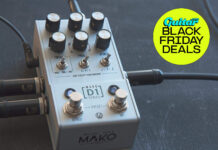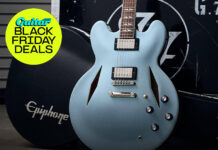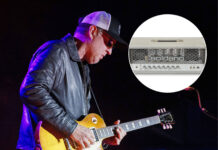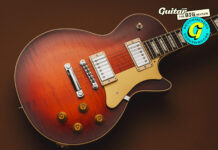
The best effects pedals to buy in 2020: 15 best guitar pedals for beginners
The world of guitar effects is full of exciting innovations and heated debate, both of which combine to make a world slightly intimidating for beginners. So we’ve picked out the best guitar pedals to buy when you’re a beginner.
What to look for when buying a guitar pedal as a beginner?
There’s nothing inherent that separates ‘beginner’ pedals from those used by pros, but there is a palpable difference between the approach you might have when buying your first pedal when compared to your 100th (yes, that might happen. Be careful).
It’s helpful to consider what you need to be added to your sound, and how your first pedal might help you get there.
Some pedals are intended to solve very specific problems that beginners probably don’t need to worry about. A digital reverb workstation the size of a small moon might make sense if you’re David Gilmour, but if you’re yet to figure out whether you prefer spring or plate reverb, you won’t need 200 types of each.
If you’re a beginner and a pedal is offering you multiple options, think: “Do I want to find out what each of those sounds like, or am I just intimidated?” There are plenty of boxes on this list that have multiple modes but accessed through a three-way toggle rather than a menu.
The best effects pedals for beginners at a glance
EHX Big Muff Rams Head (Drive)
Ibanez Tube Screamer Mini (Drive)
Orange Two Stroke (Boost/EQ)
Boss SD-1 (Drive)
T-Rex Creamer (Reverb)
TC Electronic Flashback Mini (Delay)
Ibanez Analog Delay Mini (Delay)
Laney Black Country Customs Secret Path (Reverb)
Keeley Magnetic Echo (Delay)
MXR Phase 90 (Modulation)
Dunlop Cry Baby Mini (Wah)
TC Electronic Ditto Looper (Looper)
Fender The Bends (Compressor)
MXR Six Band EQ (EQ)
EHX Soul Food (Drive)
EHX Big Muff Rams Head
Image: Electro-Harmonix+ Classic Big Muff sounds
– Might still be too muddy for some
Fuzz: it’s the sound of countless amazing guitar tones and a great start to the world of pedals, as it’s nothing like the sound of amp distortion. Rather than sweetening your amp’s overdrive, you really know when you’ve stepped on a fuzz pedal.
Read More: These are the 20 best fuzz pedals to buy now
There’s one pedal that comes highly recommended as an entry point into the style: the EHX Big Muff, and its many variations. But it’s not without its issues. While it can produce violin-like sustain and beautifully chaotic riffs, its note separation leaves a little to be desired and its scooped midrange can leave you lost in the mix when playing with a band.
The Rams Head edition, reissued last year, features the same style of fuzz but with greater string separation and a friendlier midrange character. But don’t worry – the same honky, singing distortion/fuzz character of the Big Muff is still there.
Price: £92/$99 Description: Compact reissue of the Violet Ram’s Head Big Muff fuzz pedal Controls: Volume, tone and sustain Bypass: True Bypass I/O: ¼-inch in/out Power: 9V DC
Ibanez Tube Screamer Mini
Image: Ibanez+ An affordable entry point into the world of Screamers
+ Small footprint
– Not the best at heavier drive tones by itself
If there’s one flavour of overdrive that you’ll come across the most as you begin your journey into the world of pedals, it’s the Tube Screamer. Ibanez’s miniature version of the classic circuit features the tried-and-tested sound crammed into a tiny enclosure with the simple layout of volume, tone and gain.
Read More: 20 of the best overdrive pedals
Run into a clean or slightly overdriven amplifier on a low gain setting, this pedal pushes your tone into a colourful, dynamic place, with plenty of clarity alongside the extra grunt.
But run it into a higher-gain amp, and the pedal’s mid-hump and low-end response help you achieve tight, heavy rhythm riffage. The Tube Screamer is also a great complement to other drive and fuzz pedals, giving them the extra edge in the midrange and tightening up their bass response.
Price: £65/$79.99 Description: Compact midrange-focused overdrive Controls: Level, drive and tone Bypass: True Bypass I/O: ¼-inch in/out Power: 9V DC
Orange Two Stroke
Image: Orange+ Clean boost gets more out of the gear you already have
+ Parametric EQ lets you get very precise
– Might need a tube amp to get it to truly sing
A clean boost is an ‘effect’ that lifts the level of your signal without introducing any clipping – at least, not through the pedal itself.
Read More: 10 of the best EQ pedals for guitar
The Two Stroke from Orange is a clean boost that comes with the added bonus of a two-band parametric EQ section. That EQ stage can cut or boost two frequency humps of your choosing, and introduce 12dB of overall level boost.
This makes it an incredibly versatile boost pedal, as it can be tuned to work with any and all rigs – pushing a breaking-up amp into overdrive or launching you above the mix for a solo. You can even double the pedal’s voltage to 18 volts, which increases internal headroom, so even if you hammer at your guitar, the Two Stroke will cleanly boost your signal.
Price: £109/$135 Description: Clean boost pedal with two-band parametric EQ Controls: Oil (overall boost level), high boost/cut, low boost/cut, high frequency, low frequency Bypass: True Bypass I/O: ¼-inch in/out Power: 9V-12V DC
Boss SD-1
Image: BOSS+ Tried and tested smooth overdrive
+ Boss enclosure’s durability is unparalleled
– One-trick pony
The Boss SD-1’s tube-y character, affordability and durability has earned it a reputation of being a workhorse that appears on the board of countless great players. Eddie Van Halen, Steve Vai, Kirk Hammett, Joe Satriani, The Edge, Josh Homme are all users and abusers of the yellow stompbox – not bad for something that’s just over £50.
Its character is fairly neutral, adding enough gain for a core rock tone, but not so much that your dynamics get crushed. It excels at boosting an already driven amp, too.
Price: £55/$49.99 Description: Warm, smooth overdrive aimed at blues and rock tones Controls: Level, tone and drive Bypass: Buffered Bypass I/O: ¼-inch in/out Power: 9V DC
T-Rex Creamer
Image: T-Rex+ Three of the most common reverb styles in one pedal
+ Analogue dry-through
– Might achieve what your amp can already do
The reverb pedals that come highly recommended – like the Strymon BigSky and Eventide Space – are often far too complex for beginners. Beginners neither need nor want to mess around with banks of presets, MIDI control and over a thousand types of impulse responses.
Read More: 16 of the best reverb pedals
The T-Rex Creamer streamlines everything down to three reverb modes and three controls: spring, room and hall, and tone, decay and reverb, respectively. Spring emulates the classic sound of a spring reverb tank, the in-built reverb that’s found in countless classic amps. Hall lends your tone almost ethereal ambience, and Room adds a touch of natural air and depth.
Price: £69/$174.99 Description: Three-mode reverb Controls: Reverb level, tone and decay, as well as a three-position toggle switch to choose between room, spring and hall reverb. Bypass: Buffered bypass/ I/O: ¼-inch in/out Power: 9V DC
TC Electronic Flashback Mini
Image: TC Electronics+ More versatile than it seems
+ TonePrint lets you go beyond the three knobs
– Messing around with digital editing is not for everyone
This mini version of TC Electronic’s Flashback excels at simple delay sounds, but despite its mini size and three knobs, it has a few tricks up its sleeve. Take the audio tap-tempo feature, for example. Rather than tap dance on a footswitch, the feature allows you to hold down the bypass switch and strum to set the delay time exactly how you need it.
Read More: Eight of the best delay pedals
Thanks to TC Electronic’s proprietary TonePrint tech, you can instantly load in presets for delay sounds put together by a host of guitarists, including Steve Morse, Lee Ritenour and Joe Perry. The TonePrint for Mac, PC and iPad can also introduce you to the world of deeper digital customisation when it comes to effects pedals.
Read our review of the TC Electronic Flashback Mini here.
Price: £95/$99 Description: Compact digital delay pedal Controls: Feedback, level and delay time Bypass: True bypass I/O: ¼-inch in/out Power: 9V DC
Ibanez Analog Delay Mini
Image: Ibanez+ Classic analogue delay tones
+ Great match with the TS Mini
– Not the biggest range of delay times
As the name implies, this delay is fully analogue. How important that is can vary from guitarist to guitarist, but in any case, Ibanez has packed down classic delay circuitry into a mini enclosure. Its delay time ranges from 20 to 600ms, and so it’s great for surfy slapback or even self-oscillating chaos.
Price: £89/$119.99 Description: Compact analogue delay Controls: Delay time, repeat (feedback), blend (delay level) Bypass: True Bypass I/O: ¼-inch in/out Power: 9V DC
Laney Black Country Customs Secret Path
Image: Laney+ Expands on amp-style reverb
+ Still offers traditional options
– Will benefit from extra gear
Laney’s Black Country Customs Secret Path is a triple-mode reverb pedal. Two of these are the rather straightforward spring and plate reverbs, while the last takes you down the titular “secret path”: a huge, ambient hall reverb that fades into an angelic shimmer. It’s nothing like the reverb found in most amps – a great entry point to the world of shoegaze-y, ambient guitar tones.
Price: £129/$199.99 Description: Three-mode reverb pedal Controls: Pre-delay, volume, tone and size, as well as a three-way toggle to choose between spring, plate and ‘The Secret Path.’ Push-button to access ‘enhanced’ mode for secondary sounds. Bypass: Buffered bypass I/O: ¼-inch in, 2 stereo outs, expression pedal in Power: 9V DC
Keeley Magnetic Echo
Image: Keeley+ Sought-after tape echo tones
+ In-depth controls
– Only one ‘type’ of delay
Back in the early days of rock ’n’ roll, echo effects were achieved using the write and read heads of magnetic tape recorders, which gave delay trails the frequency-limited character of the tape that was being used. As the speed of the tape became inconsistent due to wear and tear, it got worse at reproducing sound. The result, in guitar terms, is modulated delay trails that shift behind your main signal in a very pleasing way.
The Magnetic Echo from Keeley offers fine control of time, regeneration and level – as well as the depth and speed of the overall chorus-like modulation effect created by the tape emulation. It’s a fuss-free way to get rockabilly, country or experimental tones, backed by one of the most established boutique brands out there today.
Price: £159/$149 Description: Tape-emulating modulated delay pedal Controls: Time, regeneration, level, modulation depth and speed Bypass: True bypass I/O: ¼-inch in/out Power: 9V DC
MXR Phase 90
Image: MXR+ Simple operation
+ Tried-and-tested analogue sounds
– Hard to be subtle with
While this is a list for beginners, and beginners are statistically less likely to be able to play all of Eruption, the MXR Phase 90 is a great introduction to modulation as an effect. From Gilmour-esque washes to Leslie-like warbles, its one-knob operation couldn’t be simpler. At higher speed settings, the pedal introduces incredibly speedy wobbles, while at slower settings, it’s great for ambient washes or a dramatic texture shift mid-song.
Price: £83/$79.99 Description: Simple phaser pedal Controls: Phase speed Bypass: Buffered bypass I/O: ¼-inch in/out Power: 9V DC
Dunlop Cry Baby Mini
Image: Dunlop+ Small footprint
+ True bypass switching
– Not as comfortable to use, especially for those with large feet
Wah is one of the most recognisable effects out there, and thanks to Dunlop’s Cry Baby Mini it’s now achievable in a more pedalboard-friendly format. With no controls other than the (admittedly too small) foot rocker and an internal toggle switch to adjust the effect’s Q (it’s where the centre of the frequency sweep lies), the Cry Baby Mini represents an affordable and compact entry into the world of wahs.
Price: £99/$99.99 Description: Compact version of the timeless wah pedal Controls: Wah rocker Bypass: True bypass I/O: ¼-inch in/out Power: 9V DC
TC Electronics Mini Ditto Looper
Image: TC Electronic+ Small footprint and easy operation
+ Unlimited overdubs and five-minute loop limit
– No dedicated stop button
Loopers are wonderful tools to have at your disposal – especially if you’re a beginner bedroom jammer.
Read More: 12 of the best looper pedals for guitar
Want to practice over chord changes of your choosing? Or test out different tones on the same passage? The Ditto lets you do that in the most intuitive of ways: there’s only one footswitch to record, stop and playback, plus a single Loop Level knob to control the volume of the loop.
While it’s not the most full-featured looper out there, its operation couldn’t be simpler – and it’s an affordable entry point to the world of, um, playing with yourself.
Price: £71.99/$98.98 Description: Simple one-knob looper Controls: Loop level, multi-function footswitch Bypass: True bypass I/O: ¼-inch in/out Power: 9V DC
Fender The Bends
Image: Fender+ Affordable for the feature set
+ Wet/dry blend is a bonus
– Not the most exciting or inspiring effect
Compression is everywhere. Your overdrive pedals, your amps, your pickups, the mastering process of almost every single recorded piece of music released – they all compress a signal to some extent.
Read More: Eight of the best compressor pedals for guitar
In short, compression evens out the dynamics of your playing; it brings up the soft parts and quietens the loud parts. And so a dedicated compressor pedal grants you deep access to this essential process of controlling the speed, sustain and output gain of the effect. Compression can have a sound of its own, too – a single-coil into a compressor into a clean amp is a timeless sound of funk, R&B and pop, for instance.
Fender’s The Bends is a solid introduction to the utility effect. Through the Drive and Recovery knobs, the stompbox lets you squeeze your signal and extend your sustain. But the main benefit of the pedal is its Blend knob, which allows you to mix in your dry signal to retain your natural pick attack, among other quirks in your playing style.
Price: £89/$149.99 Description: Compressor pedal with wet/dry blend Controls: Drive, recovery, level and wet/dry blend Bypass: True bypass I/O: ¼-inch in/out Power: 9V DC
MXR Six Band EQ
Image: MXR+ Brings the best out of your gear
+ Doubles up as a clean boost
– Uninspiring on its own
Like compression, every piece of gear has its own inherent EQ character. But with a standalone EQ pedal, you can finetune the sound of your guitar, amp and pedals, all depending on where you position the stompbox in your chain.
Is your practice amplifier sounding too rumbly in the low-end? No need to buy a new one – just drop the 100Hz band a little. Is your new distortion pedal hissing away in the top end? Cut the 10KHz band. Can’t hear yourself when you solo? Boost the midrange when it’s your cue.
The six-band MXR EQ is a great place to start – like most of the pedals on this list, it’s compact, affordable and durable. Its six bands give you just the necessary amount of control to be considered a pure ‘utility’ pedal. Plys, the 18dB you can cut/boost each frequency band is a touch more than the comparable Boss GE-7, although the latter lets you tame or amplify the high end with a 6.4K band.
But for more precise and sophisticated alternatives, check out our guide on EQ pedals for a more in-depth look.
Price: £99/$89.99 Description: 6-band equaliser pedal Controls: six sliders for the discrete frequency bands, overall level control Bypass: Buffered bypass I/O: ¼-inch in/out Power: 9V DC
EHX Soul Food
Image: EHX+ Optional buffer
+ High headroom
– Low end is a little quiet
You buy your first guitar. Your first amplifier. You observe the wall of guitar pedals in the shop, and make a mental note to do some research on the matter. You log on to the /r/guitarpedals sub-reddit and look at the top posts. Here you see multiple references to a horse, a centaur, something arcane lost to annals of time. You get a sense that this is the tip of the iceberg.
Scouring the ancient, dusty comments sections you piece together the legend of the Klon Centaur – perhaps the best pedal of all time, it seems, thanks to its low-gain ‘transparent’ overdrive.
You look on Reverb.com for a true Klon Centaur out of curiosity. You see “£3,796.62”. You close that tab and instead purchase an EHX Soul Food for a 50th of the price.
It sounds the same. And if you think we’re being flippant, here’s a side-by-side comparison of the Klon and Soul Food by Living Room Gear Demos.
Price: £69.99/$86.20 Description: Klon-style ‘transparent’ overdrive Controls: Gain, treble and output. Bypass: Either buffered or true bypass, set with an internal switch I/O: ¼-inch in/out Power: 9V DC
For more buyers’ guides, click here.
The post The best effects pedals to buy in 2020: 15 best guitar pedals for beginners appeared first on Guitar.com | All Things Guitar.
Source: www.guitar-bass.net













